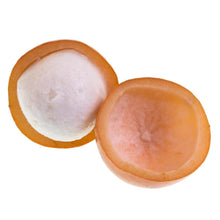Delicious Mangosteen-Like Fruit in Any Zone
Why Achacha Fruit Trees?
Exotic growth with a delectable taste that's second to none - the Achacha is in a league of its own, especially since it's an abundant producer, both in containers and in the ground.
That means the Achacha can be grown anywhere in the country, effortlessly. And they can tolerate brief temperature drops down to 30 degrees once they're established. In colder areas, simply bring the tree indoors for the winter. It quickly grows to a manageable size - reaching 20 feet when planted outdoors but only about five feet when grown in a container.
Plus, with good looks and great taste, indoor growth is highly desirable. This exotic tree has vibrant green leaves and an aromatic scent that will enhance space - the perfect contrast against its vivid, vibrant orange-red hue.
Why Fast-Growing-Trees.com is Better
Your medium to large fruit, similar to delectable (but expensive!) mangosteens found in supermarkets, may be ready for harvesting from late June to July in its first year of growth.
Seed-grown Achachas can take 6 to 8 years to produce fruit, but because we put in extra work to hand-graft your tree (adding a year or more to our own growing schedule), it's ready to thrive as soon as it arrives at your doorstep.
Basically, you can save thousands of dollars and tons of time with the Achacha - order your own today!
Planting & Care
1. Planting: Direct sunlight and lots of warmth are an Achacha Fruit Tree’s best friend. When choosing a location, whether in a container or in the ground, try to choose a place with the most hours of sunlight possible. If the container will be indoors, place it near a window. When choosing a location in the ground, avoid low areas or areas that tend to flood.
Once you have chosen the best spot for your tree, dig a hole that’s three times as wide as the pot your tree came in and just as deep. Position your tree in the hole, and make sure that it’s level with the surrounding ground, and that it is standing straight up. Backfill the hole and tamp down with your hands as you go to avoid any air pockets from forming.
For indoor planting, select a pot that has multiple drainage holes in the bottom and is two sizes bigger than the shipped container. Use organic soil mix, place your tree, then select a sunny spot for it to grow.
2. Watering: For the first 6 weeks after planting, water only once every three days. After that, you can back off to once a week and then every two weeks over the winter. During the hot months of summer, your tree may need a bit more water than over the spring or fall.
3. Fertilizing: The best fertilizer is a natural, organic one with mycorrhizal fungi and beneficial bacteria.
4. Pruning: Your goal when pruning should be to form an open crown so that light and air can penetrate to the middle of the tree. This will reduce the risk of fungus and diseases.



